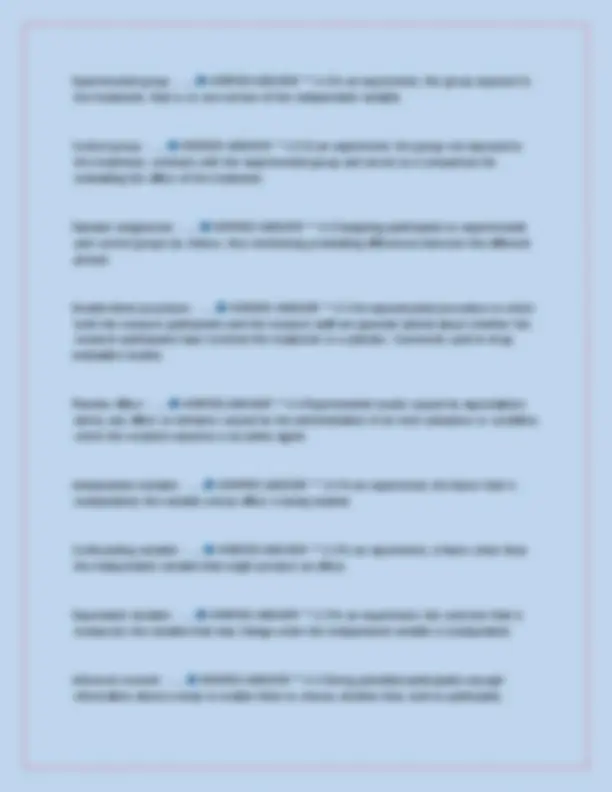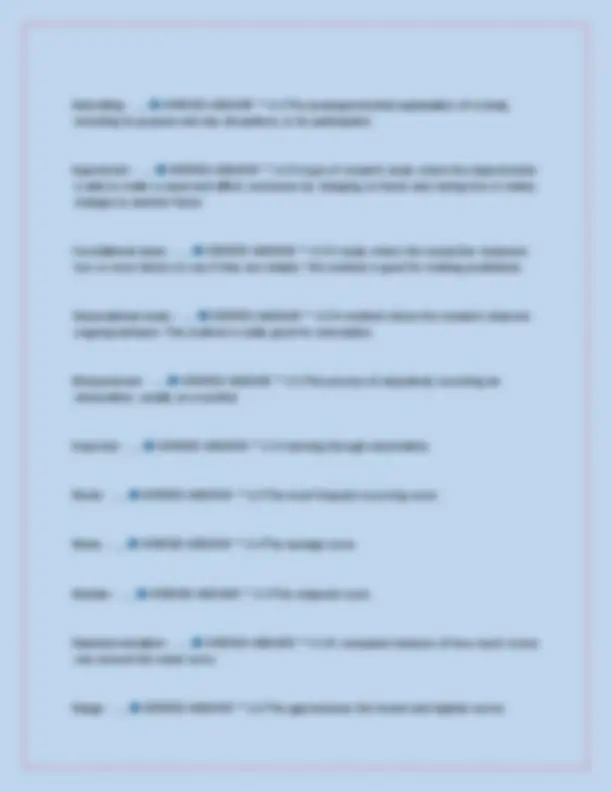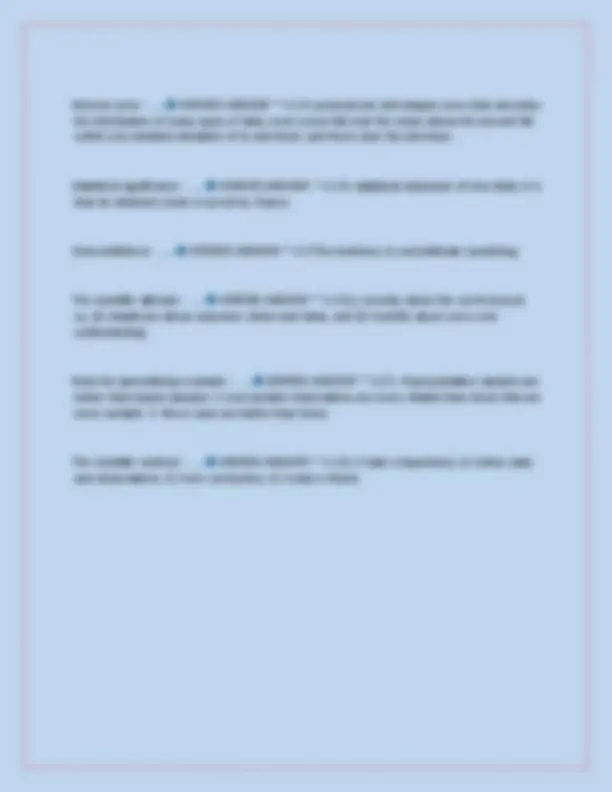





Study with the several resources on Docsity

Earn points by helping other students or get them with a premium plan


Prepare for your exams
Study with the several resources on Docsity

Earn points to download
Earn points by helping other students or get them with a premium plan
Community
Ask the community for help and clear up your study doubts
Discover the best universities in your country according to Docsity users
Free resources
Download our free guides on studying techniques, anxiety management strategies, and thesis advice from Docsity tutors
A comprehensive list of key concepts and definitions commonly used in research methodology. It covers a wide range of topics, including intuition, hindsight bias, critical thinking, theory, hypothesis, operational definition, replication, case study, naturalistic observation, survey, population, random sample, correlation, correlation coefficient, scatterplot, regression toward the mean, experimental group, control group, random assignment, double-blind procedure, placebo effect, independent variable, confounding variable, dependent variable, informed consent, debriefing, experiment, correlational study, observational study, measurement, empirical, mode, mean, median, standard deviation, range, normal curve, statistical significance, overconfidence, the scientific attitude, rules for generalizing a sample, and the scientific method. Each concept is defined clearly and concisely, making it a valuable resource for students and researchers alike.
Typology: Exams
1 / 5

This page cannot be seen from the preview
Don't miss anything!




Intuition |- |...,. VERIFIED |ANSWER |✔✔An |effortless, |immediate, |automatic |feeling |or |thought, |as |contrasted |with |explicit, |conscious |reasoning. Hindsight |bias |- |...,. VERIFIED |ANSWER |✔✔The |tendency |to |believe, |after |learning |an |outcome, |that |one |would |have |foreseen |it. |(Also |known |as |the |I-knew-it-all-along |phenomenon.) Critical |thinking |- |...,. VERIFIED |ANSWER |✔✔Thinking |that |does |not |blindly |accept |arguments |and |conclusions. |Rather, |it |examines |assumptions, |appraises |the |source, |discerns |hidden |values, |evaluates |evidence, |and |assesses |conclusions. Theory |- |...,. VERIFIED |ANSWER |✔✔An |explanation |using |an |integrated |set |of |principles |that |organizes |observations |and |predicts |behaviors |or |events. Hypothesis |- |...,. VERIFIED |ANSWER |✔✔A |testable |prediction, |often |implied |by |a |theory. Operational |definition |- |...,. VERIFIED |ANSWER |✔✔A |carefully |worded |statement |of |the |exact |procedures |(operations) |used |in |a |research |study. |For |example, |human |intelligence |may |be |operationally |defined |as |what |an |intelligence |test |measures. Replication |- |...,. VERIFIED |ANSWER |**✔✔Repeating |the |essence |of |a |research |study, |usually |with |different |participants |in |different |situations, |to |see |whether |the |basic |finding |extends |to |other |participants |and |circumstances.
Case |study |- |...,. VERIFIED |ANSWER |✔✔A |descriptive |technique |in |which |one |individual |or |group |is |studied |in |depth |in |the |hope |of |revealing |universal |principles. Naturalistic |observation |- |...,. VERIFIED |ANSWER |✔✔A |descriptive |technique |of |observing |and |recording |behavior |in |naturally |occurring |situations |without |trying |to |manipulate |and |control |the |situation. Survey |- |...,. VERIFIED |ANSWER |✔✔A |descriptive |technique |for |obtaining |the |self-reported |attitudes |or |behaviors |of |a |particular |group, |usually |by |questioning |a |representative, |random |sample |of |the |group. Population |- |...,. VERIFIED |ANSWER |✔✔All |those |in |a |group |being |studied, |from |which |samples |may |be |drawn. |(Note: |Except |for |national |studies, |this |does |not |refer |to |a |country's |whole |population.) Random |sample |- |...,. VERIFIED |ANSWER |✔✔A |sample |that |fairly |represents |a |population |because |each |member |has |an |equal |chance |of |inclusion. Correlation |- |...,. VERIFIED |ANSWER |✔✔A |measure |of |the |extent |to |which |two |factors |vary |together, |and |thus |of |how |well |either |factor |predicts |the |other. Correlation |coefficient |- |...,. VERIFIED |ANSWER |✔✔A |statistical |index |of |the |relationship |between |two |things |(from |−1.00 |to |+1.00). Scatterplot |- |...,. VERIFIED |ANSWER |✔✔A |graphed |cluster |of |dots, |each |of |which |represents |the |values |of |two |variables. Regression |toward |the |mean |- |...,. VERIFIED |ANSWER |**✔✔The |tendency |for |extreme |or |unusual |scores |or |events |to |fall |back |(regress) |toward |the |average.
Debriefing |- |...,. VERIFIED |ANSWER |✔✔The |postexperimental |explanation |of |a |study, |including |its |purpose |and |any |deceptions, |to |its |participants. Experiment |- |...,. VERIFIED |ANSWER |✔✔A |type |of |research |study |where |the |experimenter |is |able |to |make |a |cause-and-effect |conclusion |by |changing |on |factor |and |seeing |how |it |makes |changes |to |another |factor. Correlational |study |- |...,. VERIFIED |ANSWER |✔✔A |study |where |the |researcher |measures |two |or |more |factors |to |see |if |they |are |related. |This |method |is |good |for |making |predictions. Observational |study |- |...,. VERIFIED |ANSWER |✔✔A |method |where |the |research |observes |ongoing |behavior. |This |method |is |really |good |for |description. Measurement |- |...,. VERIFIED |ANSWER |✔✔The |process |of |objectively |recording |an |observation, |usually |as |a |number. Empirical |- |...,. VERIFIED |ANSWER |✔✔Learning |through |observation. Mode |- |...,. VERIFIED |ANSWER |✔✔The |most |frequent |occurring |score. Mean |- |...,. VERIFIED |ANSWER |✔✔The |average |score. Median |- |...,. VERIFIED |ANSWER |✔✔The |midpoint |score. Standard |deviation |- |...,. VERIFIED |ANSWER |✔✔A |computed |measure |of |how |much |scores |vary |around |the |mean |score. Range |- |...,. VERIFIED |ANSWER |**✔✔The |gap |between |the |lowest |and |highest |scores.
Normal |curve |- |...,. VERIFIED |ANSWER |✔✔A |symmetrical, |bell-shaped |curve |that |describes |the |distribution |of |many |types |of |data; |most |scores |fall |near |the |mean |(about | 68 |percent |fall |within |one |standard |deviation |of |it) |and |fewer |and |fewer |near |the |extremes. Statistical |significance |- |...,. VERIFIED |ANSWER |✔✔A |statistical |statement |of |how |likely |it |is |that |an |obtained |result |occurred |by |chance. Overconfidence |- |...,. VERIFIED |ANSWER |✔✔The |tendency |to |overestimate |something. The |scientific |attitude |- |...,. VERIFIED |ANSWER |✔✔(1) |curiosity |about |the |world |around |us, |(2) |skepticism |about |unproven |claims |and |ideas, |and |(3) |humility |about |one's |own |understanding. Rules |for |generalizing |a |sample |- |...,. VERIFIED |ANSWER |✔✔1. |Representative |samples |are |better |than |biased |samples. |2.Less-variable |observations |are |more |reliable |than |those |that |are |more |variable. |3. |More |cases |are |better |than |fewer. The |scientific |method |- |...,. VERIFIED |ANSWER |✔✔1) |Create |a |hypothesis, |2) |Collect |data |and |observations, |3) |Form |conclusions, |4) |Create |a |theory